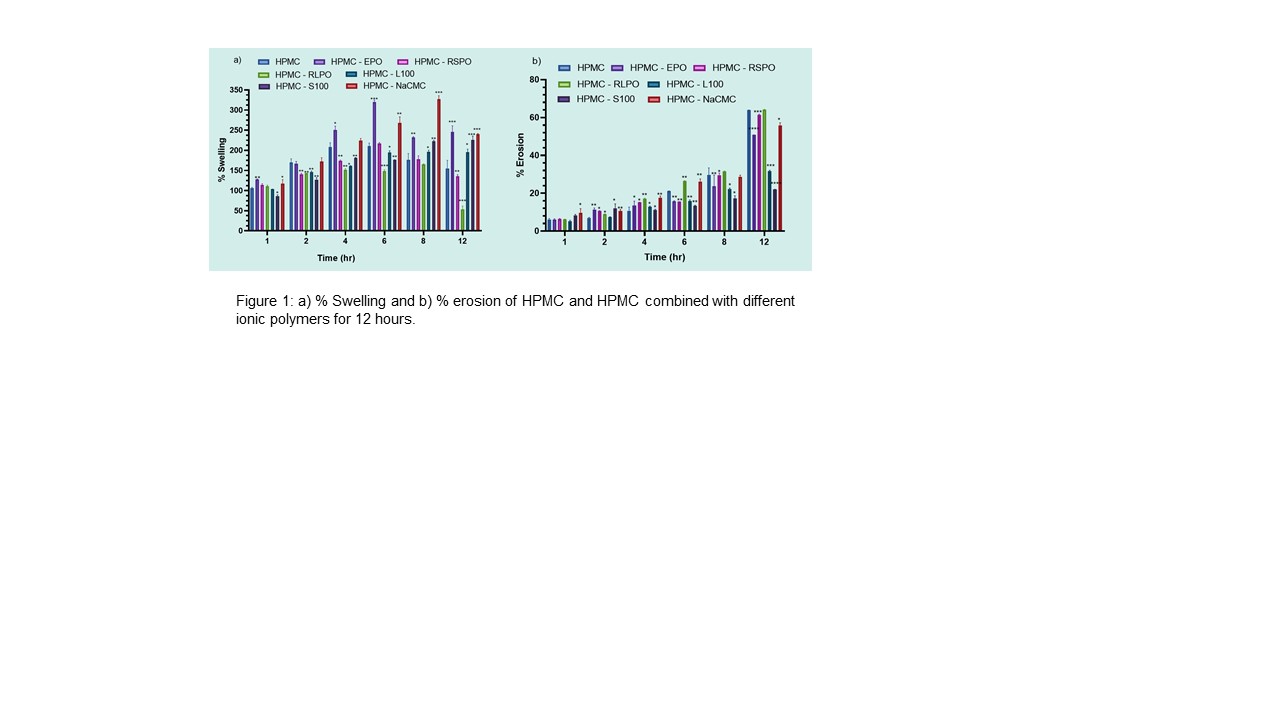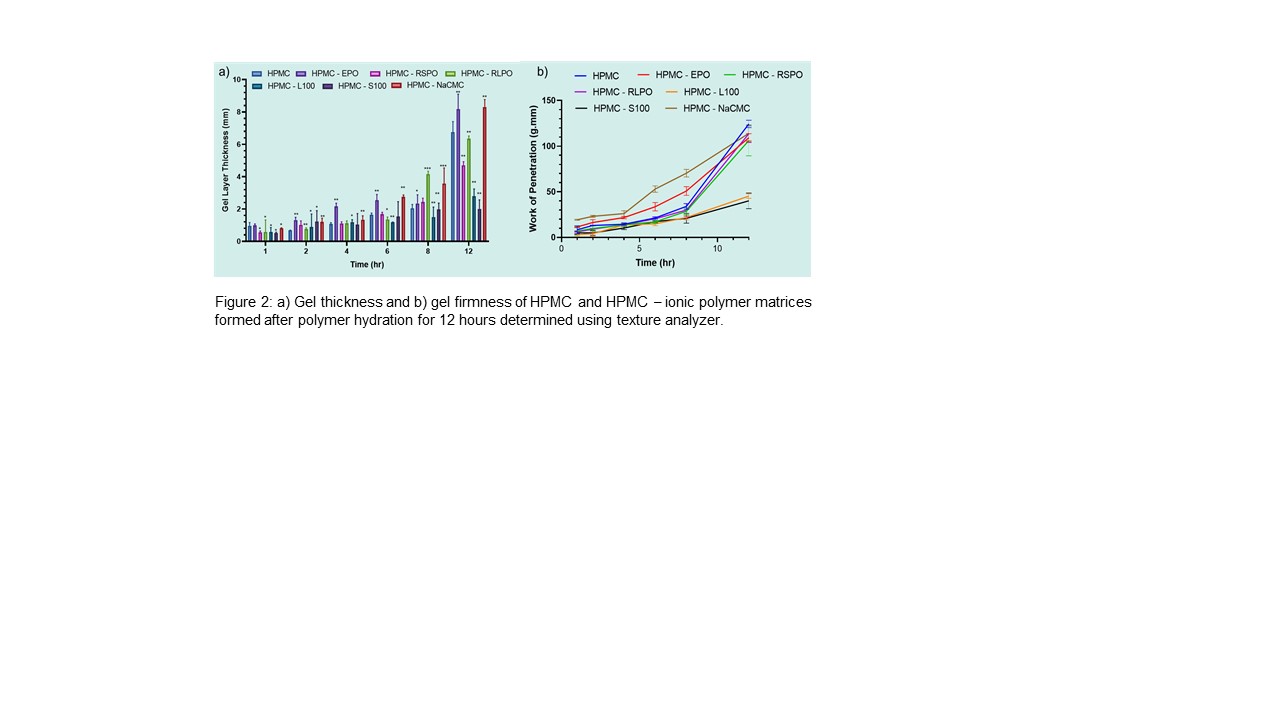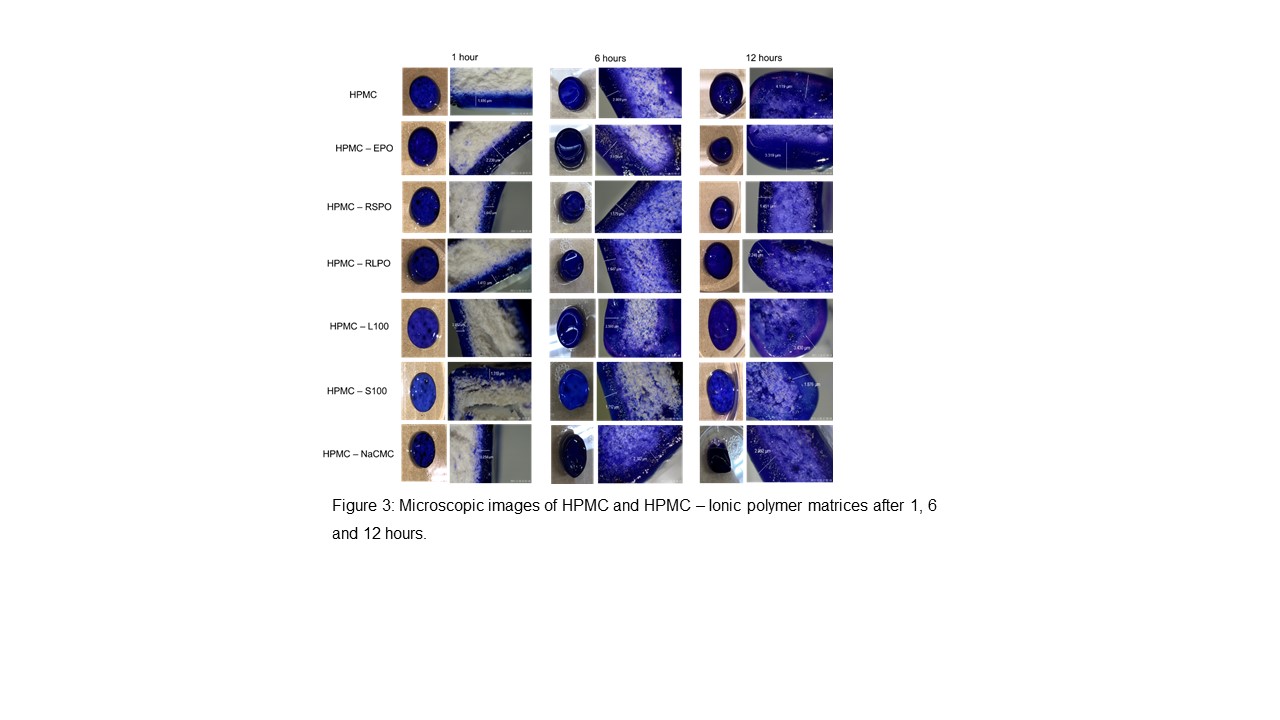Back
Purpose: Polymers have played an important part in the advancement of drug delivery technology by providing controlled release of therapeutic agents. Hydrophilic polymers are utilized in more than 75% of controlled release products in the market today. Mechanism of drug release from polymer matrix formulations involves three steps, i.e., (1) when hydrophilic polymer encounters an aqueous medium, the polymer hydrate forming a gel layer, and drug on the matrix surface is released, (2) expansion of gel layer occurs, with time and soluble drug diffuses through gel layer, and (3) ultimately erosion of polymer takes place as outer polymer dissolves in dissolution medium after its complete hydration releasing poorly-soluble drug. The swelling and erosion behavior of polymer determines drug release through these polymeric matrix systems. Knowledge of these behaviors can serve as an important preformulation tool for the formulation of a controlled release matrix system. The objective of the present study was to understand the swelling and erosion behaviors of hydrophilic polymer (HPMC) and effect of ionic polymers on these properties, using various techniques.
Methods: MethocelTM K4M (HPMC) was selected as a hydrophilic polymer. Sodium carboxymethyl cellulose (NaCMC), Eudragit® S100 (S100) and Eudragit® L100 (L100) were selected as anionic polymers. Eudragit® RSPO (RSPO), Eudragit® RLPO (RLPO) and Eudragit® EPO (EPO) were selected as cationic polymers. HPMC and ionic polymers were mixed in a ratio of 3:1, and polymeric matrix tablets were prepared by direct compression. Various techniques were used to characterize the swelling behavior of polymer matrices. Fourier-transform infrared spectroscopy was used to study polymer interaction. Water uptake and erosion studies were conducted in the dissolution media representing physiological pH (1.2 and 6.8) for 12 hours. Texture analyzer was used to investigate change in gel layer thickness and firmness of matrices over time. Microscopic examination of polymer tablets was done using a stereo microscope and scanning electron microscope (SEM).
Results: From water uptake and erosion studies, it was observed that HPMC swelling and erosion was altered by incorporation of ionic polymers. Incorporation of NaCMC and EPO increased matrix swelling whereas incorporation of S100 and L100 decreased swelling as compared to HPMC alone. The inclusion of RSPO and RLPO increased both swelling and erosion rate of HPMC matrices. Texture analyzer precisely measured force required for the probe to penetrate swollen matrices and to determine the change in gel layer thickness formed around polymer matrices with time. Gel layer thickness was found to increase with increase in swelling of matrices over time. With time, glassy core texture of matrices weakened over time. Due to the weakened core of matrices, probe continued to penetrate the matrices until it reached hold-plate of the instrument on which tablet was mounted for measurement. Therefore, it is necessary to study the work of penetration, which is the force required by probe to penetrate swollen matrices. From the work of the penetration study graph, it can be concluded that combining ionic polymer with HPMC affected not only the gel layer formation but also the core structure of the matrices. FT-IR was used to study the interaction between polymers. Relaxation of the polymer during hydration occurs because of hydrogen bonding between oxygen atoms in ether groups of HPMC and hydrogen atoms of the water molecule. The intensity of the OH- stretching peak was found to vary for all HPMC-ionic polymer combinations. It is possible that HPMC formed intramolecular hydrogen bonding with ionic polymer because of which there was reduction in number of chemical groups in HPMC available for hydrogen bonding with water during swelling. Microscopic examination with the help of a stereo microscope showed structural changes that polymer undergoes as water penetrates and continues to penetrate over a period of 12 hours. Gel layer thickness was determined visually with the help of the stereo microscope. SEM rendered a closer look into the structure of polymer matrices. It was observed that a combination of polymer-like NaCMC and EPO created a diffusion layer with larger pores which led to increased water uptake and swelling. On the other hand, the incorporation of pH-dependent polymer, L100 and S100, resulted in diffusion layer that had minimum pores acting as a barrier layer resulting in restricted water penetration.
Conclusion: An attempt was made to study hydrophilic polymers swelling and erosion behaviors. It was observed that HPMC swelling can be altered by the incorporation of ionic polymer. Amongst all, HPMC - RSPO showed swelling and erosion occurring simultaneously while maintaining constant gel layer thickness hence constant diffusion path length. The texture analyzer was helpful in determining the gel layer thickness and glassy core texture of swollen polymer matrices. FT-IR confirmed hydrogen bonding between HPMC and ionic polymers which restricted HPMC swelling and affected gel viscosity. Microscopic images proved to be a useful tool to provide information regarding the surface texture of polymer matrices.



Formulation and Delivery - Chemical - Formulation
Category: Poster Abstract
(T1530-03-13) Characterization of Swelling Behavior of HPMC alone and in Combination with Some Ionic Polymers
Tuesday, October 18, 2022
3:30 PM – 4:30 PM ET
- SB
Shapali Bagde
St. John's University
Jamaica, New York, United States - SB
Shapali Bagde
St. John's University
Jamaica, New York, United States
Presenting Author(s)
Main Author(s)
Purpose: Polymers have played an important part in the advancement of drug delivery technology by providing controlled release of therapeutic agents. Hydrophilic polymers are utilized in more than 75% of controlled release products in the market today. Mechanism of drug release from polymer matrix formulations involves three steps, i.e., (1) when hydrophilic polymer encounters an aqueous medium, the polymer hydrate forming a gel layer, and drug on the matrix surface is released, (2) expansion of gel layer occurs, with time and soluble drug diffuses through gel layer, and (3) ultimately erosion of polymer takes place as outer polymer dissolves in dissolution medium after its complete hydration releasing poorly-soluble drug. The swelling and erosion behavior of polymer determines drug release through these polymeric matrix systems. Knowledge of these behaviors can serve as an important preformulation tool for the formulation of a controlled release matrix system. The objective of the present study was to understand the swelling and erosion behaviors of hydrophilic polymer (HPMC) and effect of ionic polymers on these properties, using various techniques.
Methods: MethocelTM K4M (HPMC) was selected as a hydrophilic polymer. Sodium carboxymethyl cellulose (NaCMC), Eudragit® S100 (S100) and Eudragit® L100 (L100) were selected as anionic polymers. Eudragit® RSPO (RSPO), Eudragit® RLPO (RLPO) and Eudragit® EPO (EPO) were selected as cationic polymers. HPMC and ionic polymers were mixed in a ratio of 3:1, and polymeric matrix tablets were prepared by direct compression. Various techniques were used to characterize the swelling behavior of polymer matrices. Fourier-transform infrared spectroscopy was used to study polymer interaction. Water uptake and erosion studies were conducted in the dissolution media representing physiological pH (1.2 and 6.8) for 12 hours. Texture analyzer was used to investigate change in gel layer thickness and firmness of matrices over time. Microscopic examination of polymer tablets was done using a stereo microscope and scanning electron microscope (SEM).
Results: From water uptake and erosion studies, it was observed that HPMC swelling and erosion was altered by incorporation of ionic polymers. Incorporation of NaCMC and EPO increased matrix swelling whereas incorporation of S100 and L100 decreased swelling as compared to HPMC alone. The inclusion of RSPO and RLPO increased both swelling and erosion rate of HPMC matrices. Texture analyzer precisely measured force required for the probe to penetrate swollen matrices and to determine the change in gel layer thickness formed around polymer matrices with time. Gel layer thickness was found to increase with increase in swelling of matrices over time. With time, glassy core texture of matrices weakened over time. Due to the weakened core of matrices, probe continued to penetrate the matrices until it reached hold-plate of the instrument on which tablet was mounted for measurement. Therefore, it is necessary to study the work of penetration, which is the force required by probe to penetrate swollen matrices. From the work of the penetration study graph, it can be concluded that combining ionic polymer with HPMC affected not only the gel layer formation but also the core structure of the matrices. FT-IR was used to study the interaction between polymers. Relaxation of the polymer during hydration occurs because of hydrogen bonding between oxygen atoms in ether groups of HPMC and hydrogen atoms of the water molecule. The intensity of the OH- stretching peak was found to vary for all HPMC-ionic polymer combinations. It is possible that HPMC formed intramolecular hydrogen bonding with ionic polymer because of which there was reduction in number of chemical groups in HPMC available for hydrogen bonding with water during swelling. Microscopic examination with the help of a stereo microscope showed structural changes that polymer undergoes as water penetrates and continues to penetrate over a period of 12 hours. Gel layer thickness was determined visually with the help of the stereo microscope. SEM rendered a closer look into the structure of polymer matrices. It was observed that a combination of polymer-like NaCMC and EPO created a diffusion layer with larger pores which led to increased water uptake and swelling. On the other hand, the incorporation of pH-dependent polymer, L100 and S100, resulted in diffusion layer that had minimum pores acting as a barrier layer resulting in restricted water penetration.
Conclusion: An attempt was made to study hydrophilic polymers swelling and erosion behaviors. It was observed that HPMC swelling can be altered by the incorporation of ionic polymer. Amongst all, HPMC - RSPO showed swelling and erosion occurring simultaneously while maintaining constant gel layer thickness hence constant diffusion path length. The texture analyzer was helpful in determining the gel layer thickness and glassy core texture of swollen polymer matrices. FT-IR confirmed hydrogen bonding between HPMC and ionic polymers which restricted HPMC swelling and affected gel viscosity. Microscopic images proved to be a useful tool to provide information regarding the surface texture of polymer matrices.



